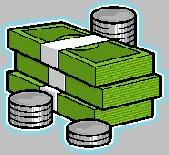
 |
|
| Financial Terms | |
| Operating Line of Credit |
|
Information about financial, finance, business, accounting, payroll, inventory, investment, money, inventory control, stock trading, financial advisor, tax advisor, credit.
Main Page: business, investment, finance, money, financial advisor, credit, inventory control, inventory, |
Definition of Operating Line of Credit
Operating Line of CreditA bank's commitment to make loans to a particular borrower up to a specified maximum for a specified period, usually one year.
Related Terms:Operating LoanA loan advanced under an operating line of credit. Annual fund operating expensesFor investment companies, the management fee and "other expenses," Bank lineline of credit granted by a bank to a customer. Best-interests-of-creditors testThe requirement that a claim holder voting against a plan of reorganization Capital market line (CML)The line defined by every combination of the risk-free asset and the market portfolio. Cash flow time-lineline depicting the operating activities and cash flows for a firm over a particular period. Characteristic lineThe market model applied to a single security. The slope of the line is a security's beta.  Comparative credit analysisA method of analysis in which a firm is compared to others that have a desired Consumer creditcredit granted by a firm to consumers for the purchase of goods or services. Also called CreditMoney loaned. Credit analysisThe process of analyzing information on companies and bond issues in order to estimate the Credit enhancementPurchase of the financial guarantee of a large insurance company to raise funds. Credit periodThe length of time for which the customer is granted credit. Credit riskThe risk that an issuer of debt securities or a borrower may default on his obligations, or that the Credit scoringA statistical technique wherein several financial characteristics are combined to form a single Credit spreadRelated:Quality spread  Crediting rateThe interest rate offered on an investment type insurance policy. CreditorLender of money. Demand line of creditA bank line of credit that enables a customer to borrow on a daily or on-demand basis. Euro lineslines of credit granted by banks (foreign or foreign branches of U.S. banks) for Eurocurrencies. EurocreditsIntermediate-term loans of Eurocurrencies made by banking syndicates to corporate and Evergreen creditRevolving credit without maturity. Federal credit agenciesAgencies of the federal government set up to supply credit to various classes of Five Cs of creditFive characteristics that are used to form a judgement about a customer's creditworthiness: Foreign tax creditHome country credit against domestic income tax for foreign taxes paid on foreign Full faith-and-credit obligationsThe security pledges for larger municipal bond issuers, such as states and Investment product line (IPML)The line of required returns for investment projects as a function of beta  Investment tax creditProportion of new capital investment that can be used to reduce a company's tax bill Letter of credit (L/C)A form of guarantee of payment issued by a bank used to guarantee the payment of Line of credit An informal arrangement between a bank and a customer establishing a maximum loan Linear programmingTechnique for finding the maximum value of some equation subject to stated linear constraints. Linear regressionA statistical technique for fitting a straight line to a set of data points. Log-linear least-squares methodA statistical technique for fitting a curve to a set of data points. One of the Line of creditAn informal arrangement between a bank and a customer establishing a maximum loan Mortgage pipelineThe period from the taking of applications from prospective mortgage borrowers to the Mortgage-pipeline riskThe risk associated with taking applications from prospective mortgage borrowers Net operating lossesLosses that a firm can take advantage of to reduce taxes. Net operating marginThe ratio of net operating income to net sales. Old-line factoringFactoring arrangement that provides collection, insurance, and finance for accounts receivable. Operating cash flowEarnings before depreciation minus taxes. It measures the cash generated from Operating cycleThe average time intervening between the acquisition of materials or services and the final Operating exposureDegree to which exchange rate changes, in combination with price changes, will alter a Operating profit marginThe ratio of operating margin to net sales. Operating leaseShort-term, cancelable lease. A type of lease in which the period of contract is less than the Operating leverageFixed operating costs, so-called because they accentuate variations in profits. Operating riskThe inherent or fundamental risk of a firm, without regard to financial risk. The risk that is Retail creditcredit granted by a firm to consumers for the purchase of goods or services. Revolving credit agreementA legal commitment wherein a bank promises to lend a customer up to a Revolving line of creditA bank line of credit on which the customer pays a commitment fee and can take Security characteristic lineA plot of the excess return on a security over the risk-free rate as a function of Security market lineline representing the relationship between expected return and market risk. Short-run operating activitiesEvents and decisions concerning the short-term finance of a firm, such as Simple linear regressionA regression analysis between only two variables, one dependent and the other explanatory. Simple linear trend modelAn extrapolative statistical model that asserts that earnings have a base level and Straight line depreciationAn equal dollar amount of depreciation in each accounting period. Swingline facilityBank borrowing facility to provide finance while the firm replaces U.S. commercial paper Trade creditcredit granted by a firm to another firm for the purchase of goods or services. OPERATING EXPENSESThe total amount that was spent to run a company this year. STRAIGHT-LINE DEPRECIATIONA depreciation method that depreciates an asset the same amount for each year of its estimated CreditBuying or selling goods or services now with the intention of payment following at some time in CreditorsPurchases of goods or services from suppliers on credit to whom the debt is not yet paid. Or a Line itemGeneric types of assets, liabilities, income or expense that are common to all businesses and Operating profitThe profit made by the business for an accounting period, equal to gross profit less selling, finance, administration etc. expenses, but before deducting interest or taxation. CreditOne side of a journal entry, usually depicted as the right side. Straight-lineA method of depreciation. bottom lineA commonly used term that refers to the net income (profit) cash flow from operating activities, or cash flow from profitThis equals the cash inflow from sales during the period minus the cash net income (also called the bottom line, earnings, net earnings, and netoperating earnings) operating activitiesIncludes all the sales and expense activities of a business. operating cash flowSee cash flow from operating activities. operating leverageA relatively small percent increase or decrease in operating profitSee earnings before interest and income tax (EBIT). straight-line depreciationThis depreciation method allocates a uniform Operating Cash FlowIncome available after the payment of taxes, plus the value of the Security Market LineA graph illustrating the equilibrium relationship between the degree of operating leveragea factor that indicates how a percentage change in sales, from the existing or current line employeean employee who is directly responsible for linear programminga method of mathematical programming used to solve a problem that involves an objective function and multiple limiting factors or constraints long-term variable cost a cost that was traditionally viewed as a fixed cost Management Accounting Guidelines (MAGs)pronouncements of the Society of Management Accountants of operating budgeta budget expressed in both units and dollars operating leveragethe proportionate relationship between product line marginsee segment margin red-line systeman inventory ordering system in which a red regression lineany line that goes through the means (or averages) of the set of observations for an independent variable and its dependent variables; mathematically, there is a line of “best fit,” which is the least squares regression line timelinerepresentation of the amounts and timing of all Operating expenseAny expense associated with the general, sales, and administrative Operating incomeThe net income of a business, less the impact of any financial activity, Operating leaseThe rental of an asset from a lessor, but not under terms that would credit analysisProcedure to determine the likelihood a customer will pay its bills. credit policyStandards set to determine the amount and nature of credit to extend to customers. degree of operating leverage (DOL)Percentage change in profits given a 1 percent change in sales. line of creditAgreement by a bank that a company may borrow at any time up to an established limit. operating leverageDegree to which costs are fixed. operating risk (business risk)Risk in firm’s operating income. security market lineRelationship between expected return and beta. straight-line depreciationConstant depreciation for each year of the asset’s accounting life. Credit CrunchA decline in the ability or willingness of banks to lend. Credit RationingRestriction of loans by lenders so that not all borrowers willing to pay the current interest rate are able to obtain loans. 45-Degree LineA line representing equilibrium in the goods and services market, on a diagram with aggregate demand on the vertical axis and aggregate supply on the horizontal axis. Related to : financial, finance, business, accounting, payroll, inventory, investment, money, inventory control, stock trading, financial advisor, tax advisor, credit. |